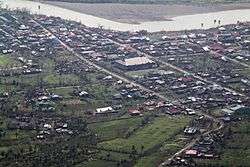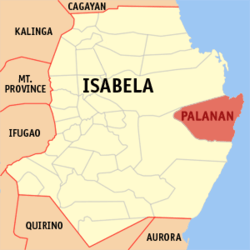Palanan
| Palanan | ||
|---|---|---|
| Municipality | ||
| Municipality of Palanan | ||
 Aerial view of Palanan after Super Typhoon Megi (PAGASA name:Juan) | ||
| ||
 Map of Isabela with Palanan highlighted | ||
.svg.png) Palanan Location within the Philippines | ||
| Coordinates: 17°03′32″N 122°25′48″E / 17.0589°N 122.43°ECoordinates: 17°03′32″N 122°25′48″E / 17.0589°N 122.43°E | ||
| Country |
| |
| Region | Cagayan Valley (Region II) | |
| Province | Isabela | |
| District | 2nd District of Isabela | |
| Founded | 1823 | |
| Barangays | 17 (see Barangays) | |
| Government [1] | ||
| • Type | Sangguniang Bayan | |
| • Mayor | Bernie Bernardo | |
| • Vice Mayor | Rody Bernardo Jr. | |
| • Electorate | 9,550 voters (2016) | |
| Area [2] | ||
| • Total | 880.24 km2 (339.86 sq mi) | |
| Population (2015 census)[3] | ||
| • Total | 17,260 | |
| • Density | 20/km2 (51/sq mi) | |
| Time zone | UTC+8 (PST) | |
| ZIP code | 3334 | |
| PSGC | 023121000 | |
| IDD : area code | +63 (0)78 | |
| Climate type | Tropical rainforest climate | |
| Income class | 1st municipal income class | |
| Revenue (₱) | 152,996,507.05 (2016) | |
| Poverty incidence | 48.6 (2012)[4] | |
| Native languages |
Paranan Ibanag Ilocano Paranan Agta Tagalog | |
| Website |
www | |
Palanan, officially the Municipality of Palanan, is a 1st class municipality in the province of Isabela, Philippines. According to the 2015 census, it has a population of 17,260 people.[3]
The town is one of the remote and isolated community of Isabela separated from the rest of the province by the Sierra Madre Mountains. It is also a suburb of Ilagan, the provincial capital. No roads connect the municipality to the rest of Isabela. It can only be reached by a plane or boat ride, or a multi-day hike from San Mariano town, also a suburb of Ilagan.[5]
It was in Palanan that one of the final chapters of the Philippine-American War was written on March 23, 1901, when Emilio Aguinaldo was captured by American forces led by Gen. Frederick Funston, who had gained access to Aguinaldo's camp by pretending to surrender to the Filipinos.
Barangays
Palanan is politically subdivided into 17 barangays. [2]
- Alomanay
- Bisag
- Culasi
- Dialaoyao
- Dibewan
- Dicadyuan
- Dicotkotan
- Diddadungan
- Didyan
- Dimalicu-licu
- Dimasari
- Dimatican
- Ditambali
- Maligaya
- Marikit
- Centro East (Poblacion)
- Centro West (Poblacion)
Demographics
| Population census of Palanan | |||||||||||||||||||||||||||||||||||||||||||||||||
|---|---|---|---|---|---|---|---|---|---|---|---|---|---|---|---|---|---|---|---|---|---|---|---|---|---|---|---|---|---|---|---|---|---|---|---|---|---|---|---|---|---|---|---|---|---|---|---|---|---|
|
| ||||||||||||||||||||||||||||||||||||||||||||||||
| Source: Philippine Statistics Authority[3][6][7][8] | |||||||||||||||||||||||||||||||||||||||||||||||||
In the 2015 census, the population of Palanan, Isabela, was 17,260 people,[3] with a density of 20 inhabitants per square kilometre or 52 inhabitants per square mile.
Transportation
The most common forms of transportation in Palanan are by horses, motorcycles, tricycles, or an improvised motorcycles called kuligligs.[5][9]
Because of its isolation, Palanan can be reached quickest by a 23-30 minute flight in a six-seater, single-engine Cyclone Air Cessna commuter plane from Cauayan City. Palanan is served by the Palanan Municipal Airport.[5][9]
By water, a boat ride from the towns of Dingalan or Baler in Aurora province in the south takes about six to seven hours.[9]
By land, Palanan can also be reached by hiking over the Sierra Madres from San Mariano, Isabela, which could take about three to five days.[10]
Climate
| Climate data for Palanan, Isabela | |||||||||||||
|---|---|---|---|---|---|---|---|---|---|---|---|---|---|
| Month | Jan | Feb | Mar | Apr | May | Jun | Jul | Aug | Sep | Oct | Nov | Dec | Year |
| Average high °C (°F) | 27 (81) |
27 (81) |
29 (84) |
28 (82) |
27 (81) |
25 (77) |
26 (79) |
27 (81) |
31 (88) |
29 (84) |
27 (81) |
27 (81) |
28 (82) |
| Average low °C (°F) | 20 (68) |
20 (68) |
21 (70) |
20 (68) |
21 (70) |
20 (68) |
21 (70) |
22 (72) |
23 (73) |
23 (73) |
21 (70) |
21 (70) |
21 (70) |
| Average precipitation mm (inches) | 162 (6.38) |
156 (6.14) |
90 (3.54) |
60 (2.36) |
144 (5.67) |
201 (7.91) |
159 (6.26) |
108 (4.25) |
111 (4.37) |
237 (9.33) |
276 (10.87) |
171 (6.73) |
1,875 (73.81) |
| Average rainy days | 14 | 12 | 11 | 11 | 16 | 19 | 16 | 14 | 16 | 18 | 18 | 15 | 180 |
| Source: World Weather Online[11] | |||||||||||||
References
- ↑ "Municipality". Quezon City, Philippines: Department of the Interior and Local Government. Retrieved 31 May 2013.
- 1 2 "Province: Isabela". PSGC Interactive. Quezon City, Philippines: Philippine Statistics Authority. Retrieved 12 November 2016.
- 1 2 3 4 Census of Population (2015). "Region II (Cagayan Valley)". Total Population by Province, City, Municipality and Barangay. PSA. Retrieved 20 June 2016.
- ↑ "PSA Releases the 2012 Municipal and City Level Poverty Estimates". Quezon City, Philippines: Philippine Statistics Authority. Archived from the original on 28 January 2017. Retrieved 28 January 2017.
- 1 2 3 Christian (2011-06-13). "Palanan and Maconacon". Off the Beaten Track in the Philippines. Retrieved on 2014-09-28.
- ↑ Census of Population and Housing (2010). "Region II (Cagayan Valley)". Total Population by Province, City, Municipality and Barangay. NSO. Retrieved 29 June 2016.
- ↑ Censuses of Population (1903–2007). "Region II (Cagayan Valley)". Table 1. Population Enumerated in Various Censuses by Province/Highly Urbanized City: 1903 to 2007. NSO.
- ↑ "Province of Isabela". Municipality Population Data. Local Water Utilities Administration Research Division. Retrieved 17 December 2016.
- 1 2 3 Jay (2013-01-09). "Palanan - Isabela's Best Kept Secrets". Lets Go Philippines. Retrieved on 2014-09-28.
- ↑ "The Palanan Trails". Waypoint.PH. Retrieved on 2014-09-28.
- ↑ "Palanan, Isabela: Average Temperatures and Rainfall". World Weather Online. Retrieved 31 October 2015.
External links
| Wikimedia Commons has media related to Palanan. |
- Municipal Profile at the National Competitiveness Council of the Philippines
- Palanan at the Isabela Government Website
- Local Governance Performance Management System
- Philippine Standard Geographic Code
- Philippine Census Information
- Municipality of Palanan
- Palanan.org
- Palanan, Isabela – The Last Stand of the First Philippine Republic
- Chasing Waterfalls: Disadsad Falls
- Off-The-Beaten-Path: Dicotcotan Beach
